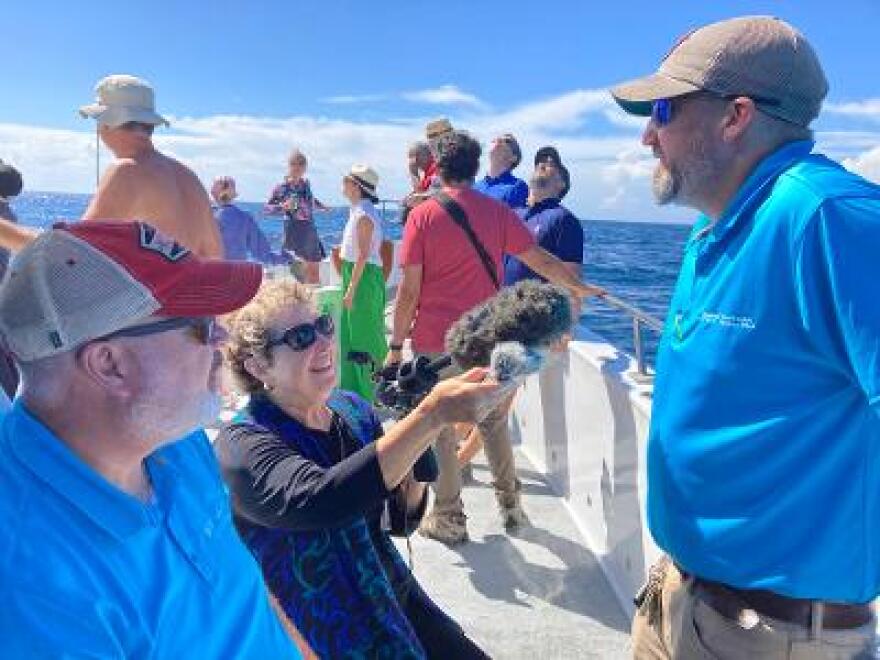Setting out from a dock off Virginia Beach, passengers on board the Rudee Angler couldn’t even see the test turbines – even when one blade stretched 620 feet up. Dominion spokesman Jeremy Slayton was not surprised.
“On a picture-perfect, super clear day at the right elevation you may be able to make them out from shore," he said. "If you’re standing on the beach, you won’t be able to see them."
But the utility has been watching those turbines for nearly two years. John Larson, Dominion’s director of public policy, has visited 21 times.
“Obviously wind is new to us," he explains. "It’s a great way to learn on two turbines, before you have 176 you need to maintain.”
The first thing they’ve concluded is that these modern windmills work really well. The next generation of turbines will be even taller – able to power 660,000 homes, and they can likely withstand winds of 150 miles per hour. .
“We looked at 94,000 storms – the recorded history of this area, and they can go up to a category 3 hurricane," Larson says. "Keep in mind that offshore wind started in the North Sea, which has just tremendous seas and winds on a pretty constant basis.”
One reason for their resilience – the blades are designed to tilt relative to the wind.
“At a little over 60 miles an hour the turbine will yaw or rotate to reduce load, and the blades are able to be feathered," he says. Comparing it to someone putting their hand through the window of a moving car he adds, "There’s pressure, but if you turn your hand horizontal and flat, there’s almost no pressure on it.”

From the test turbines, observers also concluded construction did not disturb wildlife.
“We recently saw three loggerhead sea turtles," says Taryn Paul a naturalist aboard the rudeee Angler. "We also saw about eight hammerhead sharks and two manta rays feeding by the wind turbines."
Dominion’s Jeremy Slayton says the turbine foundations, surrounded by boulders, serve as artificial reefs where fish can shelter.
“It attracts smaller fish, and the smaller fish attract bigger fish and bigger fish, so it’s a haven for fishermen.”
And there is no sign that construction had an impact on marine mammals – whales, dolphins and seals. Larson says builders were able to create a curtain of bubbles that minimized the sound of piles being driven into the ocean floor.
“We put two walls of bubbles down to look at reducing the aquatic signature of that pile driving. It actually reduced it significantly, so that was a good lesson learned for us, the industry and all the regulators about how to mitigate sounds so that you don’t distract any type of marine life.”
That said, Dominion will not be installing foundations when endangered North Atlantic Wright whales are nearby.
“Their migration period runs from October/November until May, up and down the coast, so our installation will only take place from May 1 through the end of October,” Larson says.
Marine mammals, he adds, are curious creatures. If they hear something, they’re likely to investigate, and Dominion doesn’t want to disturb their migration.
Work on the 150-square-mile wind farm is set to begin in 2024 when the utility completes construction of a special vessel used to install turbines. Slayton says the $500 million craft had to be built here in the U.S. to comply with federal regulations.
“It will be the first Jones Act-compliant offshore wind turbine installation vessel, which is really important to the offshore wind supply chain in the U.S. It’ll be used in the Northeast on two projects up there before we use it to install our turbines.”
Dominion hopes to finish by 2026, permits permitting. Getting the paperwork past federal regulators was, Larson says, another learning experience.
Once the turbines are up and running, they will probably be most productive in the fall, winter and spring.
“Think about the dog days of summer when you just wish that wind would blow and cool you off," Larson says. "The wind is not going to be blowing out here, and that’s why having a diverse portfolio that includes solar is great, because our solar irradiation is very good in the summer in Virginia.”
Dominion claims that by 2030 the Coastal Virginia Offshore Wind Park or C-VOW will lower carbon emissions by 55%. Meanwhile, Larson says, Virginia is building a new industry around offshore wind – anticipating creation of 5,000 jobs building, installing and maintaining turbines. Some consumers worry that the $9.8 billion project could boost monthly charges for residential customers beyond the projected increase of about $5- $14 a month. In approving the project, the state put new requirements on Dominion and outlined situations where shareholders or the legislature might chip in.
This report, provided by Virginia Public Radio, was made possible with support from the Virginia Education Association.


